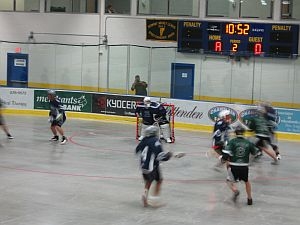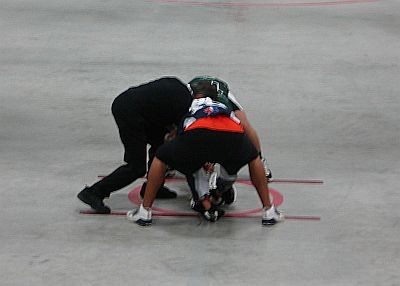
(Host) Lacrosse traces its roots back several hundred years.
Originally, teams could have hundreds of athletes playing at once, with goals set miles apart and games lasting for several days. Rules for the sport were finally codified in the 1860s.
Seventy years later, Canadians took the game inside, playing matches in ice hockey rinks that weren’t being used during the summer months. The "new" game became known as box lacrosse to differentiate it from the field variety.
This summer, a team of Vermonters has been playing a 10-game schedule of box lacrosse.
VPR’s Ric Cengeri took in a game in Essex during the Vermont Voyageurs’ final weekend of action.
(Cengeri) The game is played inside the dasher boards of a hockey rink, but players run on a concrete floor rather than ice. Each side has five field players and a goalie, all wielding lacrosse sticks, which are in essence poles with baskets on the end.

Players catch and flick the hard rubber lacrosse ball for shots at the four-foot by four-foot goal in one imperceptible motion. They’re sent to the penalty box when they commit serious infractions [door slam] and they bang their sticks loudly when their team scores. [banging sticks]
Trevor Wagar of the Voyageurs, who played lacrosse at the University of Vermont, offers his description of the indoor game.
(Wagar) "It’s a combination of basketball and hockey and other sports all into one. I think because of that diversity and the diversity that’s being picked up by the sport and the people playing now, it just makes it more intriguing. More fun to play."
(Cengeri) The uniforms the players wear in box lacrosse mirror Wagar’s marriage of hockey and basketball – helmets and shoulder pads combined with gym shorts and sneakers.
Ripley Harrison played lacrosse in high school in Ohio and then at UVM. He has an aesthetic way of contrasting field or outdoor lacrosse with the box version.
(Harrison) "For me, I think it brings out the creativity that’s been a little bit lost in the field game because you have to make quick decisions, you have to be very unique with your stick, almost like an artist with the way you take your brush strokes around the goal to see if you can score. My big love for box is just the frenetic pace, the end-to-end excitement."
(Cengeri) Box lacrosse is frenetic. Teams have just 30 seconds to take a shot on goal once they gain possession of the ball.
Voyageurs’ Coach Jeff Culkin:
(Culkin) "It definitely keeps the pace high speed. Many more shots on the net. You don’t get the lapses in play. What I think attracts the general lacrosse fan is the stick work. These guys are taking shots that are a hundred miles an hour from six to eight yards away from the goalie. You don’t even see the ball."
(Cengeri) The Voyageurs roster is comprised of local players who finished their college careers but were looking to keep their hand in the game.
(Clukin) "We’ve got guys that are engineering students. We have a medical student up at the University of Vermont Medical School. We have three public school teachers. We have a graphic designer. We’ve actually got five players on our roster who have been drafted by pro teams at one time or another"
(Cengeri) With season-ending victories over the Rochester Greywolves and Kahnawake Mohawks, the Vermont Voyageurs finished the year with a 4-6 record.
(Announcer) "Vermont goal scored by #6 Ripley Harrison. The time of the goal was at 7 minutes."
For VPR News, I’m Ric Cengeri.
(Host) The Voyageurs played an independent schedule this summer, and plan to become members of the Quebec Senior Lacrosse League in 2010.